How To Fly Safely With a Drone Over Water – 10 Tips
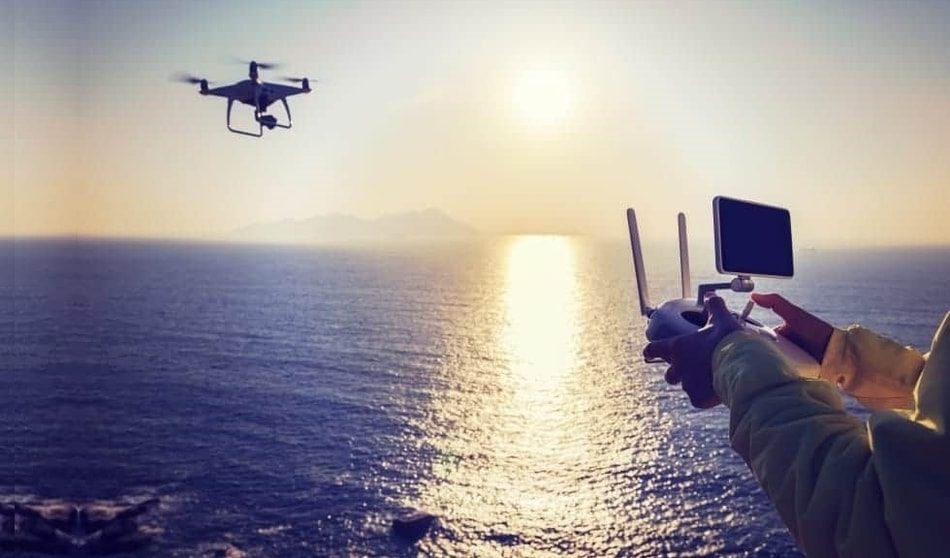
You already had a great flight maneuvers on land and were able to capture really great pictures. Now it is time for new challenges and you are already planing to capture some amazing videos over water. Flying with your drone over water can be a scary thing for most drone pilots.
It sounds very simple, but it carries many dangers and potential risks. The diverse coastal regions offer impressive motifs for aerial photography.
We will here clarify the potential dangers of flying a drone over water, the sea or the open sea and give you a helpful tips to avoid accidents. Flying over water is not at all harmless, and we will explain to you exactly what we mean.
If you are an inexperienced pilot, it is better to refrain from such experiments. After reading this article, you will learn how to prepare and control your drone over water so you can protect your quadcopter from accidents.
There are 2 ways you can fly with your drone over water:
1. Launching Your Drone From a Beach
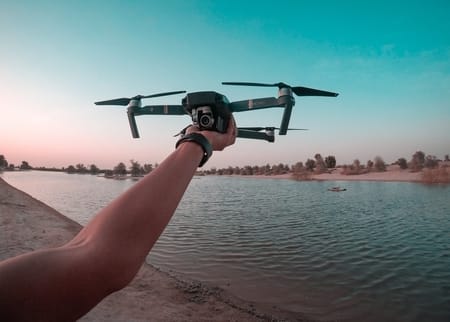
2. Launching Your Drone From a Boat
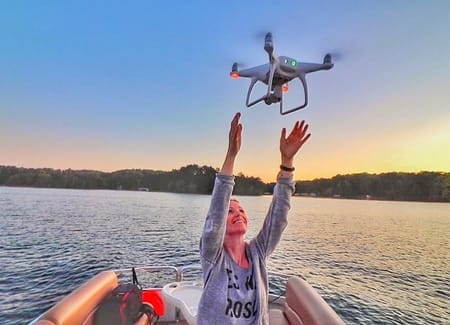
10 Tips How To Fly With Your Drone Over Water
| How To Fly Safely Over Water: |
|---|
| 1. Disable Vision Positioning System (VPS) |
| 2. Plan the Filming Process in Detail |
| 3. Set The Maximum Flight Distance |
| 4. You Can’t Do It Without Practice |
| 5. Don’t Get Distracted |
| 6. Manually Update the Home Point Mode (take-off point) |
| 7. Avoid Obstacles and Dangers When Flying Above Water |
| 8. Use Intelligent Mode - Course Lock |
| 9. Pay Attention To Wind Speed Because It Affects Battery |
| 10. Beware of Birds |
1. Launching a Drone From a Beach
When a drone takes off from the beach, there are some rules that you must follow to make the flight as safe as possible. If you are on a sandy beach you must know that there is a lot of salt in the sand that has accumulated, which is very harmful to the drone’s electronics.
So, when the drone is taking off, the propellers start to spin and the sand also kicks up into the air. Therefore, the best way is to ask your friend to help you to launch a drone from his hand (safely). If you are alone on the beach use a towel or launch pad as a take off and landing position.
Also don’t launch your drone if you are close to the water. Try to be as far away from the beach as possible when you take off, because if something bad happens during the flight, the drone returns to its RTH (return to home) position.
And if you find yourself at the place where big waves appear near the beach, your drone will just land at that place and he will be caught in the water. So be sure and launch your drone as far away from the beach as possible. By following these rules you will avoid all potential inconveniences that can happen.
Related Article: How Long Can A Drone Fly?
2. Launching a Drone From a Boat
Even if you already have some flight experience with a drone; launching a drone from a boat is tricky and can present some challenges. Flying from a moving object carries various dangers. One of the things that can happen is that you lose connection to your drone.
Let’s say you want to film the route between points A and B on the sea. Then you take the boat to point B, switch on the drone there and wait until it has saved the home position (fast green flashing).
Make a rough note of where that point is. You may be able to orient yourself on striking points on the beach or on buoys. Finally, you drive to point A, start the drone and he flies towards to point B. This has the huge advantage that the drone in the direction of travel in an emergency flies and you can easily “hunt” him in a Fail-safe mode.
However, the distance between A and B should not exceed the distance of your drone’s normal range, otherwise errors can occur.
If the drone receives the GPS signal and stores the home position, the drone should not move. This is really difficult on the open sea and you will hardly reach a complete standstill. You still have these four options to ensure a stable position :
- Boat should no longer drive and should only float in the water.
- On small boats, all passengers need to sit down, so that the boat don’t rock automatically.
- Place the boat against the waves.
- Wait for the waves to pass.
Note: Your quadcopter need to be fully charged while driving from point A to point B. Expect the shorter flight time because of the wind!
Top 10 Tips For Flying Drones Over Water
1. Disable Vision Positioning System (VPS)
Modern camera drones – such as DJI Phantom 4, DJI Mavic 2 or DJI Mavic Air – have a wide variety of sensors for obstacle detection and positioning.
The VPS (Vision Positioning System) is one of the sensors we must turn off! The VPS of camera drones functions as a vision positioning system that stabilizes the drone at low altitudes. Using ultra-fast processors, the data can be compared with one another as part of a position or height measurement.
Thanks to the Vision Positioning System, take-off and landing processes can be carried out extremely safely and stably. The VPS enables centimeter-precise positioning, both indoors or with a weak GPS signal.
If the drone flies over water, the light reflected by the water surface can cause malfunctions in the vision positioning system.

“The performance of Vision Positioning System and Infrared Sensing System are affected by the surface being flown over.”
In addition to light reflections, the VPS can also be disturbed by low-contrast or changing surfaces, so that reliable operation, especially over water and other reflective or low-contrast surfaces (including snow-covered, transparent or translucent surfaces) is not guaranteed. It is, therefore advisable in any case to deactivate the Vision Positioning System when flying over water.
2. Plan the Filming Process in Detail
Flying over water is always fraught with dangers, but detailed planning will help you to avoid accidents. So the best way is to plan the shooting before: finding the right place, presenting the perfect image/video and performing several test shots on land. This is necessary to make sure that the camera angles are set correctly. This way you can get a good shot.
3. Set The Maximum Flight Distance
Although the drone can fly over water at long distances, you should not let your drone out of sight if you plan to stay above water for a longer time. Make sure that the settings in application are set to the maximum flight range.
This function can be activated in the remote control settings by selecting the “Enable Max Distance” mode. Enter a new value for the maximum distance, making sure that you set a parameter that is within the capabilities of the remote control.
With all current drones, the maximum flight height must not exceed 500 meters, whereas the maximum flight distance can be freely configured (as far as the type of transmission of the drone allows).
If the drone leaves the maximum radius or exceeds the maximum flight distance, it automatically returns to the permissible range that is provided if the GPS signal is strong enough. When flying over the sea or larger lakes, it is advisable to adjust the maximum flight distance in the app. So if you plan to take pictures at greater distances, increase the flight distance of the drone.
Attention: Despite the technical possibilities, the visual flight rule according to guidelines and laws (e.g. drone regulation ) for the use of a drone should of course be observed.
4. You Can’t Do It Without Practice
If you want to let your drone fly above or near water, you should master the manual take-off and landing process from the inside out. The same applies to the flight commands in the air.
So before you make a flight, it’s best to practice first: learn how to launch a drone, land on the ground, and after that you are ready to fly over water. Having mastered these skills you can better, more confident and safer control your drone anywhere.
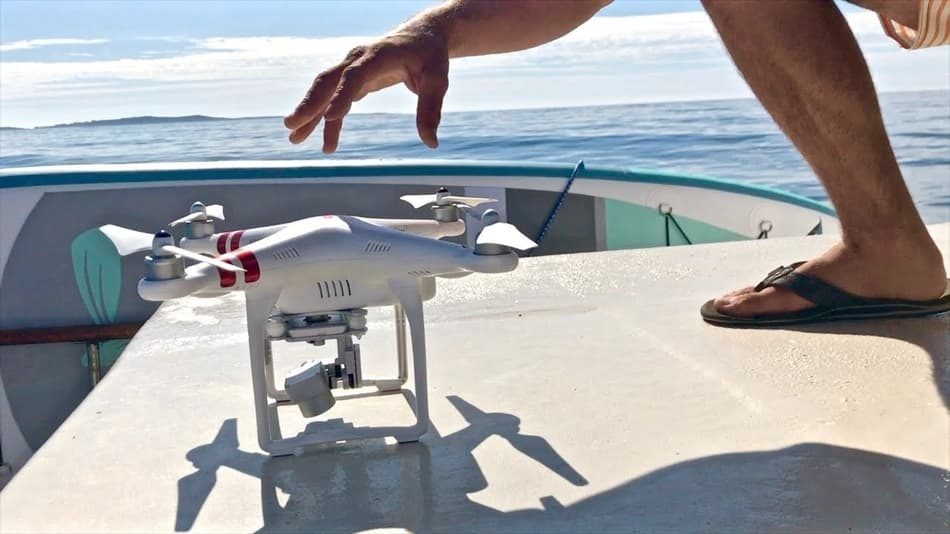
For beginners it is not recommended to fly with a drone over or near water.
When flying over water, launch can be carried out in two ways: from land or from a boat. Take-off from the surface of the earth (beach) is the most common way to take-off with a drone.
If you launch a drone into the air from a boat, try to start the flight before the engines of the boat start to work. In this condition, the boat has a stable position and it is safer. Take-off from a moving boat is possible only at low speeds, but it is better to refrain from it.
5. Don’t Get Distracted
When you decide to fly over water, you need your concentration at 100%. Flying a drone is difficult in itself, so if you are with friends, ask them not to disturb you. Also, you have to watch out for things like obstacles, as you could lose signal or your drone could go out of sight which can be a big problem.
6. Manually Update the Home Point Mode (take-off point)
When flying over land, the take-off point is usually located where the drone was launched into the air. In ideal conditions, the drone will use its compass/GPS system to automatically record the return point, which can be viewed in the app.
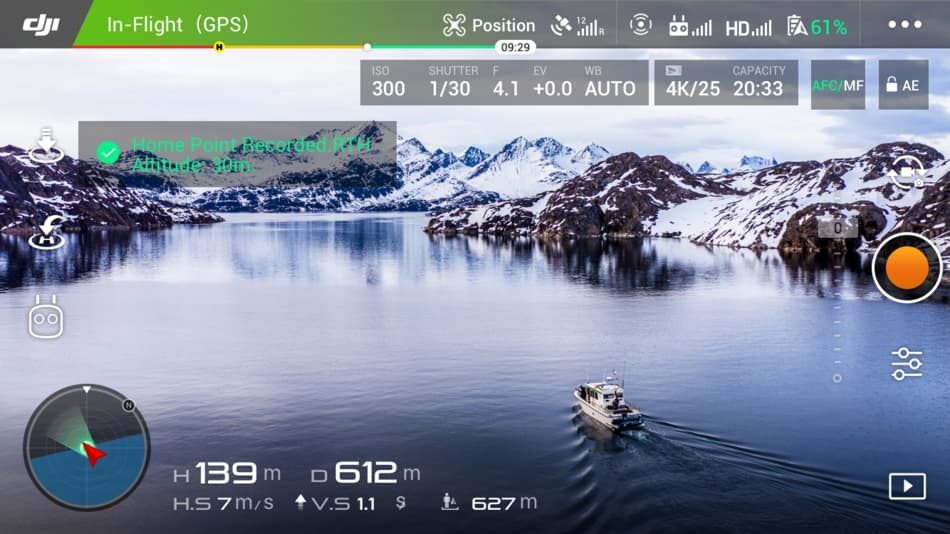
Using the “take-off point” is much more difficult when starting from a boat, as it is in motion and often drifts. In such circumstances, you may need to install a new take-off point. How exactly? Using the DJI GO App or the app your drone uses. There are two ways to do this:
- First step: you need to move to the left on the main screen and click on the “Home point” tab, then open the basic settings by clicking on the three dots in the upper right corner.
- Next step: go to the “Main Controller Settings” tab and click on the “Home Point” button (a button with a picture of a person and a take-off point).
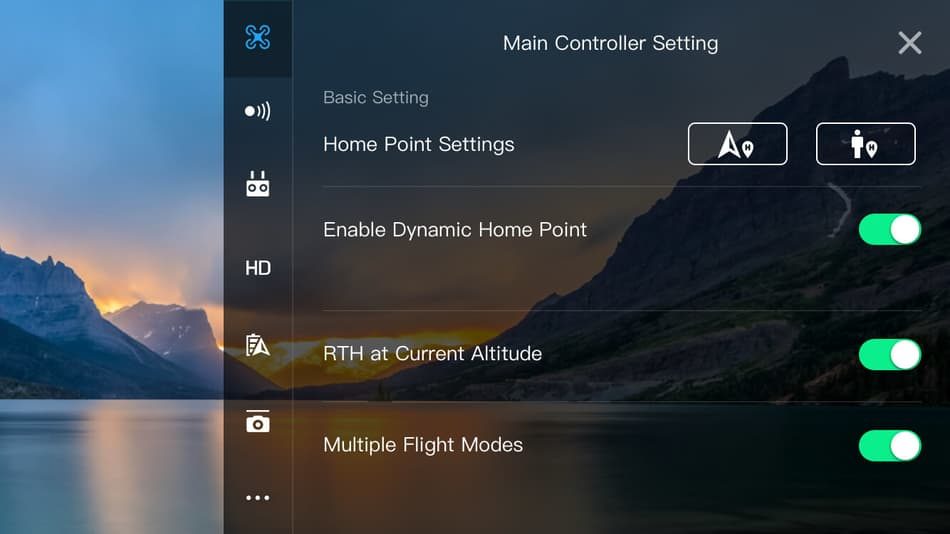
7. Avoid Obstacles and Dangers When Flying Above Water
When traveling on water, obstacles can be encountered on the way, so you should paid special attention, otherwise they can become a serious threat to the drone. This includes trees, rocks, cliffs or buildings such as lighthouses or container ships.
Even if the open sea in particular gives a very safe impression, one should still keep an eye out for obstacles. Waves can also be dangerous if drone flies at low altitude and cause the drone to crash.
As part of the return to home function, an appropriate flight height for the return should be defined, which is not only above the height of smaller boats, but also above the height of tankers and cargo ships, cruise ships or container ships.
Despite the open sea, you should also be prepared for interference that can affect or disrupt the GPS signal or the compass of the drone. Intelligent flight functions should therefore be used with extreme caution. So, before starting the drone, make sure that there are no obstacles in your sight.
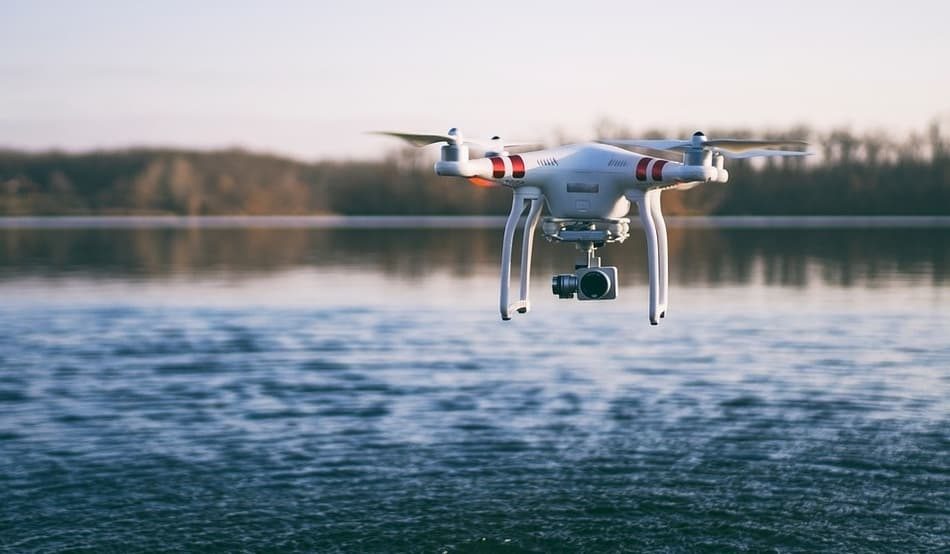
8. Use Intelligent Mode – Course Lock
Intelligent flight modes help you get professional-level images with one click. When flying over water, you can use one of the most useful features that drone have – Course Lock: which allows the user to pre-set the flight path.
All you need to do is choose the path that the drone will make and that’s it. The drone will fly automatically, and the operator will be able to concentrate on shooting interesting and fascinating shots above water.
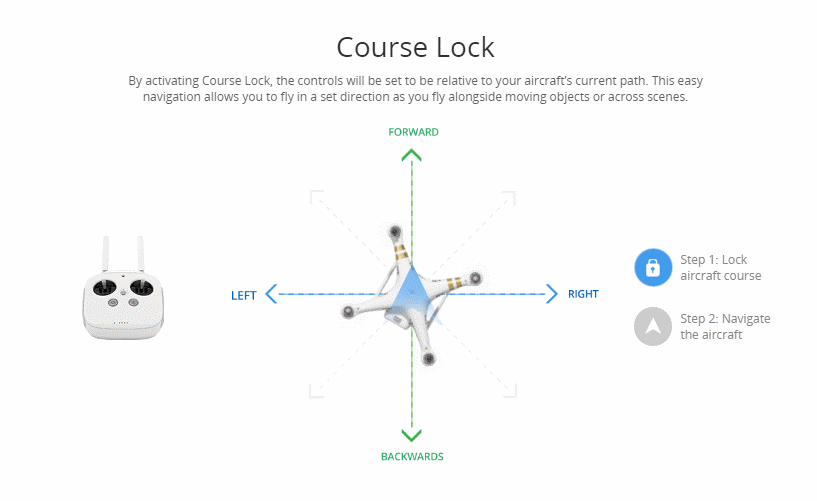
9. Pay Attention To Wind Speed Because It Affects Battery
Drone pilots are well aware that strong winds can cause unstable drone flight. In the vicinity of coastal regions and directly above the sea, a stronger wind is usually to be expected than on the surface of the land. While strong winds are directly on the beach and over the open sea, only a mild breeze blows inland. Drone pilots should therefore prepare for unrestrained wind and higher wind speeds when they fly over sea.
Since modern drones with GPS and other sensors counteract the drift by wind with the help of control commands, additional energy is required. Therefore, strong wind also affects the flight time of a drone. For this reason, pilots should be prepared for a shorter flight time when flying a drone over the sea and should not underestimate the necessary distance for the return flight from the sea to land.
10. Beware of Birds
And lastly, you need to know that birds often know to fly over water to catch fish, so you also need to pay attention to birds. Some people even try to take pictures of birds up close during the mid-flight, which can be dangerous if they start attacking your drone. So try to avoid birds.
Related Article: Recovering Your Drone From a Salt Water
When Launching The Drone Ends Wrong
At the start, some things can go wrong, as this video shows:
If you don’t want the same thing to happen to your drone as we saw here, there are a few things you should do. First of all, the boat should be at a standstill when you take off. I would also highly recommend starting your drone from your hand.
A wave or gust of wind can come quickly at sea. If things go badly, your quadcopter crashes into the side wall and then disappears into the sea.
So to minimize this risk follow my recommendations from this article. As usual, you should first look at how the drone behaves in the air shortly after take-off. The same recommendations apply to landing: stop the boat and best catch the drone by hand.
Conclusion
Flying over water is a dangerous and difficult task. A moment of carelessness can cause death or serious damage to your drone. Now I’ve given you many tips on how to minimize all risks when flying a drone from a beach or a boat. You should always carefully study the surroundings and manage with extreme caution, observing safety rules.
However, I cannot guarantee that nothing will happen to your drone. But If you follow all these rules, everything is going to be well! I would be delighted if you share your experience with us here in the comments! You are also welcome to share your drone videos here, which you recorded from a boat!


